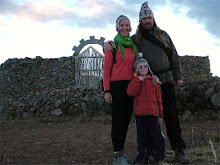It's About Time
We finally did it. We kept saying we would, but even here in Africa, life seems to interfere all too often. We get all wrapped up in other things and put off until tomorrow what we are perfectly capable of doing today. We committed on Wednesday and made good on our word on Thursday.
Thursday was Africa Day, a holiday throughout the region. We had no school so we spent the day lazing away. We went swimming midday, then came home to get cleaned up. We fed Zachary some food we knew he’d eat, loaded into In Sha Allah, and headed for the village.
The man who runs the meat counter at the mine village market is named Togolla(sp?). He speaks the most English of anyone in the store. I have mentioned him before; he is the man who commented in a previous entry about Americans being more tolerant. He is a very nice man. He owns a restaurant in the village.
The place has been open for about six months. I had told him several months ago that we would try to make it in on a Sunday evening. Apparently he heard me promise and, of course, I forgot we even talked about it. He was very upset that we did not make it in on the aforementioned evening.
Ultimately, it’s my fault. Unfortunately, my memory is about as long as my…nose. I felt terrible. I explained the situation to Carrie and she quickly explained to Togolla what a dork I am and what a poor memory I have. It took some time, but eventually he was placated and came to laugh at me as well. Whew! I certainly hadn’t meant to offend him, but I’m afraid I did just that.
Last night we went. We told him on Wednesday that we would be by around six. He asked Carrie what kind of food she liked. It was only then that we remembered that Malian restaurants often only serve what they serve. There is a main dish offered each night and that is what is for sale. Don’t ask for a menu or a Carte du Mange, there isn’t one. You take what they give you. Thus the reason for feeding Z before we went out..
We arrived shortly after six. Dinner was on the table and again we were chastised for being late. Two beef dishes, a veggie plate, fresh rolls, and a big bowl of Mango. The food was lekker! We stuffed ourselves and still had leftovers. When I queried about the bill, he asked us to pay what we felt it was worth. Aside from the fact that the place was hotter than the hinges of Hades, it was a terrific experience.
After the meal he insisted that we see his house and meet his family. We strolled through the village, gazing at this and gawking at that. It’s hard to blend when you never will. We encountered several students, rediscovered places we had been before, and eventually ended up at Togolla’s home.
We walked past several children on our way through the main gate. Once inside, we discovered a beautiful little courtyard. There was guava trees and mango trees, chickens, goats, and kids; the proper Malian household. We met his wife, sat in his hammock, and admired his livestock. As the sun started its daily farewell, we made our way back to the car and our cookie cutter white bread life.
We agreed that, barring any unsavory bowel issues, we would definitely head back to his place to engage in more culinary delights.
MJR



















































